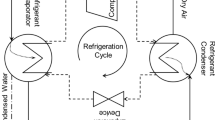Abstract
Despite of the fact that Earth’s atmosphere has abundant freshwater inform of moisture, water scarcity is one of the crucial problems especially in humid, hot, and drought prone regions. The conventional systems which extracts atmospheric water are very bulky, incompatible with the existing system, energy intensive, impractical, low water yield and expensive. These adverse effects hinder their deployment for large scale applications. In this manuscript, a water harvesting device is deigned and fabricated for extracting water from moist air. The device uses vertical copper pipes entrenched in horizontal Al fins as the condensing surfaces. All the components of the device functions on solar powered energy. The proposed device is environment friendly, compact, lightweight, low manufacturing, and maintenance cost. The device generate water with turbidity of 40 PPM. Results shows that condensation rates strongly depend on the relative humidity, saturation temperature of the moist air, and degree of subcooling. In this device, the cost of water is estimated as Rs. 10 per liter. This device is efficient for providing drinkable water in hot and humid, water scare regions globally.
Access this chapter
Tax calculation will be finalised at checkout
Purchases are for personal use only
Similar content being viewed by others
Abbreviations
- A :
-
Cross-sectional area of rectangular duct (mm2)
- \(\bar{C}\) :
-
Cost of solar energy in India (Rs.)
- C :
-
Cost of producing 1 L of water from the proposed device (Rs.)
- C p :
-
Specific heat capacity (J/kg K)
- dp:
-
Total pressure increased in the fan (N/m2)
- ΔT:
-
Degree of subcooling (℃)
- E total :
-
Total energy requirements of the device (kWh)
- m :
-
Condensation rate (l/h)
- m cond :
-
Amount of condensed water collected during the experiment (l)
- \(\dot{m}\) :
-
Mass flow rate of water-cooling unit (kg/s)
- M a :
-
Mass of air (28.963 kg/Kmol),
- M v :
-
Mass of water vapor (18.02 kg/Kmol),
- N max :
-
RPM of the fan at maximum speed
- N req :
-
RPM of the fan at required speed
- P 0 :
-
Total atmospheric pressure (bar)
- P fan :
-
Power requirement of fan modules (kW)
- P sat :
-
Pressure corresponding to saturation temperature (bar)
- P total :
-
Total energy requirement of the water harvesting device (kW)
- P WC :
-
Power requirement of water-cooling unit (kW)
- Q N :
-
Flow rate of moist air at the required speed (m3/s)
- Q max :
-
Flow rate of moist air at the maximum speed (m3/s)
- RH:
-
Relative humidity (%)
- t :
-
Total time of condensation experiment (hours)
- T :
-
Moist air temperature (℃)
- V max :
-
Maximum speed (m/s)
- a:
-
Properties of dry air
- m:
-
Properties of moist air
- v:
-
Properties of water vapor
- w:
-
Properties of water
- CFM:
-
Cubic feet per minute
- PPM:
-
Parts per million
- RPM:
-
Revolutions per minute
References
Wahlgren RV (2001) Atmospheric water vapour processor designs for potable water production: a review. Wat Res 35(1):1–22
Hamed AM, Kabeel AE, Zeidan ESB, Aly AA (2010)A technical review on the extraction of water from atmospheric air in arid zones. JP J Heat Mass Transf 4(3):213–228
El-Ghonemy AMK (2012) Fresh water production from/by atmospheric air for arid regions, using solar energy: review. Renew Sustain Energ Rev 16(8):6384–6422
Liu XH, Yi X, Jiang Y (2011) Mass transfer performance comparison of two commonly used liquid desiccants: LiBr and LiCl aqueous solutions. Energ Convers Manag 52:180–190
Ming T, Gong T, de Richter RK, Wu Y, Liu W (2017) A moist air condensing device for sustainable energy production and water generation. Energ Convers Manag 138:638–650. https://doi.org/10.1016/j.enconman.2017.02.012
Eslami M, Tajeddini F, Etaati N (2018) Thermal analysis and optimization of a system for water harvesting from humid air using thermoelectric coolers. Energ Convers Manag 174:417–429. https://doi.org/10.1016/j.enconman.2018.08.045
Jradi M, Ghaddar N, Ghali K (2012) Experimental and theoretical study of an integrated thermoelectric-photovoltaic system for air dehumidification and fresh water production. Int J Energ Res 36(9):963–974. https://doi.org/10.1002/er.1848
Bamisaye OS, Oke PK (2019) Modelling the condensed water discharge rate in air conditional system in south west, Nigeria. Curr J Appl Sci Technol 32(3):1–13
Suryaningsih S, Nurhilal O (2016) Optimal design of an atmospheric water generator (AWG) based on thermo-electric cooler (TEC) for drought in rural area
Gerard RD, Worzel JL (1972) Atmospheric water extraction over the ocean, beneficial modifications of the marine environment. In: Symposium sponsored by national research council and department of the interior, Washington DC, 11 Mar, 1968. National Academy of Sciences, Washington, DC, pp 66–84
Harrison LG (1996) Water recovery device for reclaiming and refiltering atmospheric water. Patent Appl 5,553,459
Rosenthal RA (1999) Atmospheric water extractor and method. Patent Appl 5,857,344
Tsilingiris PT (2008) Thermophysical and transport properties of humid air at temperature range between 0 and 100 ℃. Energ Convers Manag 49(5):1098–1110. https://doi.org/10.1016/j.enconman.2007.09.015
Kumari M, Mudgal LK, Singh AK (2013) Comparative studies of physico-chemical parameters of two reservoirs of Narmada river, MP, India. Curr World Environ J 8(3):473–478. https://doi.org/10.12944/cwe.8.3.18
Acknowledgements
The authors acknowledge the financial support from Science and Engineering Research Board (SERB), Department of Science and Technology (DST), Govt. of India (Project No. ECR/2016/000020).
Author information
Authors and Affiliations
Corresponding author
Editor information
Editors and Affiliations
Rights and permissions
Copyright information
© 2021 The Author(s), under exclusive license to Springer Nature Singapore Pte Ltd.
About this paper
Cite this paper
Baghel, V., Sikarwar, B.S. (2021). Performance Investigation of Atmospheric Water Generating Device for Hot and Humid Conditions. In: Sikarwar, B.S., Sundén, B., Wang, Q. (eds) Advances in Fluid and Thermal Engineering. Lecture Notes in Mechanical Engineering. Springer, Singapore. https://doi.org/10.1007/978-981-16-0159-0_4
Download citation
DOI: https://doi.org/10.1007/978-981-16-0159-0_4
Published:
Publisher Name: Springer, Singapore
Print ISBN: 978-981-16-0158-3
Online ISBN: 978-981-16-0159-0
eBook Packages: EngineeringEngineering (R0)




